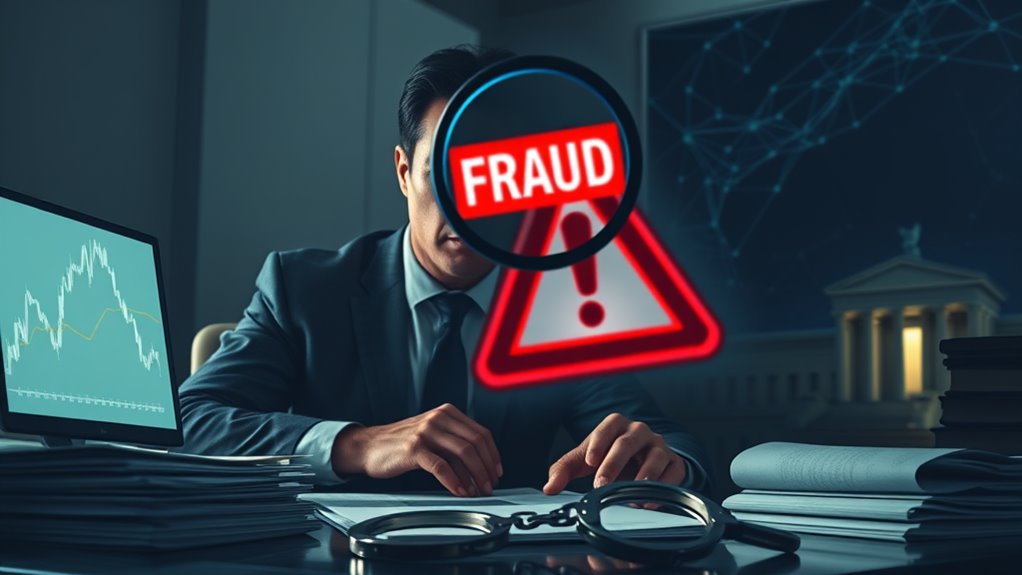
Crypto Scams and Legal Protections: Top Safeguards You Need
Cryptocurrency scams have grown increasingly sophisticated, with over $1 billion lost in 2024 alone. Effective protection requires multilayered security measures including two-factor authentication, cold storage for long-term holdings, and vigilance against common red flags like unrealistic returns and artificial urgency. Regulatory bodies like the SEC and CFTC provide some oversight, but jurisdictional challenges remain. Thorough research of platforms, verification of regulatory compliance, and awareness of emerging threats offer the strongest safeguards against potential fraud.
Key Takeaways
- Implement two-factor authentication and use hardware wallets (cold storage) to significantly reduce unauthorized access risks.
- Verify regulatory compliance of platforms and be skeptical of promises offering unrealistic returns or “risk-free” investments.
- Report suspicious activities to financial authorities like SEC, CFTC, and FinCEN for potential legal recourse.
- Recognize pressure tactics like countdown timers and limited allocation claims as red flags of potential scams.
- Store recovery phrases in secure physical locations and keep most assets in cold storage for long-term protection.
The Rising Threat of Cryptocurrency Phishing Attacks

Numerous cryptocurrency investors and users now face an escalating danger in the form of sophisticated phishing attacks.
These scams combine advanced technology with social engineering tactics to deceive victims into revealing sensitive financial information, particularly private keys.
Cybercriminals leverage sophisticated tools and psychological manipulation to extract critical crypto assets from unsuspecting users.
The statistics are alarming—2024 has already witnessed over $1 billion in losses across 296 incidents. This represents a significant escalation from 2017, when phishing attacks cost 30,287 victims approximately $225 million.
Common techniques include personalized emails with malicious links, address poisoning, impersonation of legitimate entities, and malware distribution.
The decentralized nature of cryptocurrency, combined with limited regulatory protections and inadequate exchange safeguards, creates an environment where these scams thrive.
As blockchain technology rapidly expands, so too does user vulnerability to increasingly convincing phishing attempts. Implementing two-factor authentication can significantly reduce the risk of unauthorized access to your accounts.
Recognizing and Avoiding Ponzi Schemes in the Digital Asset Space

As cryptocurrency markets continue to expand, Ponzi schemes have evolved into a significant threat within the digital asset space, costing investors billions of dollars annually.
Notable cases like HyperVerse and GainBitcoin have defrauded investors of $1.89 billion and $12.8 billion respectively, highlighting the severe financial risks.
To protect yourself from crypto Ponzi schemes, watch for these warning signs:
- Promises of unrealistic returns with minimal risk
- Overly complex investment structures using confusing technical language
- Heavy emphasis on recruiting new investors rather than legitimate value creation
Protection requires thorough research into platform legitimacy, verification of regulatory compliance, and implementation of personal risk management strategies. The regulatory landscape is evolving rapidly, with countries retrofitting existing laws to address emerging digital asset activities and ensuring consumer protection.
When in doubt, report suspicious activities to financial authorities immediately, as recovery of lost funds is often challenging.
How Regulatory Bodies Are Combating Crypto Fraud

While cryptocurrency markets continue to grow exponentially, regulatory bodies worldwide have established increasingly sophisticated frameworks to combat digital asset fraud. Key agencies including the SEC, CFTC, FinCEN, and DOJ coordinate efforts through specialized divisions like the National Cryptocurrency Enforcement Team (NCET).
These agencies enforce thorough regulations including Know-Your-Customer (KYC) requirements, Anti-Money Laundering (AML) protocols, and the Bank Secrecy Act. Recent initiatives include FinCEN’s proposed rule requiring exchanges to collect more detailed KYC data for transactions exceeding $3,000.
Additionally, the OFAC guarantees cryptocurrency transactions comply with economic sanctions. Effective AML and KYC measures are essential for building trust among users and ensuring market stability.
State-level regulations complement federal oversight, with New York and California implementing their own frameworks. These multi-layered approaches, combined with proactive fraud detection tools and risk-based monitoring systems, form the backbone of regulatory protection in the crypto space.
Essential Security Measures for Your Digital Wallet

Securing a cryptocurrency wallet requires implementing multiple layers of protection against increasingly sophisticated cyber threats. Users should differentiate between hot wallets for frequent transactions and cold storage solutions for long-term holdings, always selecting providers with established security credentials.
Effective protection strategies include:
- Enable two-factor authentication and use unique, complex passwords that aren’t shared across other accounts.
- Regularly update wallet software to guarantee security patches are installed promptly.
- Store recovery phrases in physically secure locations separated from digital devices.
For significant cryptocurrency holdings, hardware wallets offer superior protection by keeping private keys offline.
Additionally, users should always verify transaction details before confirming and avoid accessing wallets through public Wi-Fi networks, which can expose sensitive data to interception.
Legal Recourse for Victims of Cryptocurrency Scams

Victims of cryptocurrency scams face significant obstacles when attempting to recover stolen assets, particularly when transactions cross international borders.
Asset recovery often requires specialized blockchain forensic services, which can be costly and may not guarantee success in retrieving lost funds.
Legal jurisdictional challenges further complicate recovery efforts, as laws governing cryptocurrency vary widely between countries, creating gaps that sophisticated scammers exploit to avoid prosecution.
Asset Recovery Options
Many victims of cryptocurrency scams face the intimidating challenge of recovering their stolen assets, but legal pathways do exist for those seeking recourse. When pursuing asset recovery, victims should focus on thorough documentation and professional assistance.
Recovery strategies typically include:
- Transaction tracking – Forensic analysis of blockchain transactions can help identify where funds were transferred, providing critical evidence for recovery efforts.
- Legal intervention – Consulting with law firms specializing in cryptocurrency fraud can result in court-ordered freezing of assets or enforcement actions against identifiable perpetrators.
- Exchange cooperation – Reporting incidents to cryptocurrency exchanges may lead to account freezes if stolen funds haven’t yet been converted or transferred out of the platform.
The success of recovery efforts often depends on how quickly victims act and the traceability of the specific cryptocurrency involved. Additionally, the evolving regulatory landscape surrounding DeFi operations can impact the effectiveness of recovery strategies as regulations continue to shape the environment for both victims and perpetrators.
Cross-Border Legal Challenges
Despite growing awareness of cryptocurrency scams, the international nature of digital asset crime creates substantial hurdles for victims seeking legal recourse.
The lack of consistent global regulations and agreements makes enforcement particularly challenging across jurisdictions.
Cryptocurrency’s inherent features—anonymity, decentralization, and instant cross-border transactions—allow scammers to operate outside traditional financial oversight.
While cases like *Perusa v. Bensouda* demonstrate courts’ willingness to issue worldwide freezing orders, these remain limited precedents rather than universal solutions.
Law enforcement faces significant obstacles when tracing and freezing assets in foreign territories, complicated by varying legal frameworks and recognition of court orders.
The absence of uniform international regulations creates regulatory grey areas that scammers exploit.
Effective resolution often requires specialized blockchain intelligence and greater international cooperation among regulatory authorities. Furthermore, as cryptocurrencies are legal in over 119 countries, the diverse regulatory approaches can complicate the enforcement of legal protections for victims.
Red Flags That Signal a Potential Crypto Investment Scam

Among the most recognizable signs of crypto investment scams are promises of extraordinary returns that deviate from market norms and seem too good to be true.
Legitimate investments always carry risk, so guarantees of “risk-free” opportunities with unusually high profits should immediately trigger skepticism among potential investors.
Scammers often create artificial urgency through limited-time offers or pressure tactics, attempting to rush investors into decisions before they can conduct proper research or seek professional advice. Additionally, potential investors should be aware of the importance of anti-money laundering (AML) regulations, which are designed to protect individuals and businesses from fraudulent schemes.
Unrealistic Returns Promised
When evaluating cryptocurrency investment opportunities, unrealistic returns stand as one of the most glaring red flags that signal potential fraud.
Legitimate investments never guarantee fixed returns in the volatile crypto market, while scams often promise daily yields of 20% or more—mathematically impossible to sustain long-term.
Three key indicators of return-based scams include:
- Promises of fixed daily percentages (like 27% daily) that compound to thousands of percent annually
- Complete absence of risk explanations or disclaimers about potential losses
- Complex, opaque investment strategies designed to confuse rather than inform investors
Historical examples like YieldTrust demonstrate how these schemes inevitably collapse once new investor funds can no longer support the promised payouts, leaving most participants with substantial losses. Furthermore, investors should always verify the regulatory compliance of any platform before engaging, as this is critical to avoiding scams.
Pressure to Invest
Recognizing high-pressure investment tactics represents one of the most reliable ways to identify cryptocurrency scams before falling victim. Legitimate investments allow time for due diligence, while scammers create artificial urgency to prevent proper research. When promoters employ aggressive marketing strategies demanding immediate action, investors should proceed with extreme caution.
| Warning Sign | What It Looks Like |
|---|---|
| Countdown timers | “Only 24 hours left to join this exclusive opportunity” |
| Limited allocation claims | “Only 50 spots remaining for early investors” |
| Unreasonable deadlines | “Wire funds within 2 hours to secure your position” |
| Escalating bonuses | “Invest now for 30% bonus, tomorrow only 10%” |
These tactics aim to bypass rational decision-making processes. Legitimate opportunities remain available without extreme time pressure, allowing thorough verification of investment claims. Additionally, investors should be aware that countries with bans on cryptocurrencies may indicate heightened risk and regulatory scrutiny.
Cold Storage Solutions for Maximum Asset Protection

In the increasingly vulnerable digital landscape of cryptocurrency, cold storage presents itself as the gold standard for protecting digital assets from online threats. By keeping private keys completely offline, these solutions markedly reduce exposure to hacking, malware, and phishing attempts.
When selecting cold storage options, users should consider:
- Hardware wallets – Devices like Ledger and Trezor that offer advanced security features and dApp integration capabilities.
- Paper wallets – Cost-effective physical documents containing key information, though vulnerable to environmental damage.
- Security protocols – Implementing backup strategies, secure physical storage, and proper key management practices.
While cold storage requires more technical knowledge than hot wallets and sacrifices some convenience, this tradeoff provides superior security for long-term cryptocurrency holdings and maximum asset protection. Additionally, users should regularly update their security software to defend against emerging threats, further enhancing their overall security posture.
Cross-Border Enforcement and International Crypto Regulations

Maneuvering the complex web of international cryptocurrency regulations presents substantial challenges for both users and regulators alike.
Jurisdictional complexities arise as transactions frequently cross multiple borders with varying legal frameworks, creating regulatory gaps.
The Financial Action Task Force (FATF) establishes global standards for combating money laundering and terrorism financing, influencing over 200 countries.
FATF sets worldwide anti-money laundering standards, shaping crypto regulations across more than 200 jurisdictions.
Its Travel Rule requires companies to share transaction details exceeding specific thresholds.
Meanwhile, regulatory approaches differ markedly worldwide—the US treats most cryptocurrencies as securities, while the EU implements its MiCA framework.
Enforcement relies heavily on blockchain intelligence tools like Chainalysis to track suspicious transactions.
International collaboration among agencies, such as J5, has become essential for effective regulation.
As the crypto landscape evolves, continuous monitoring of regulatory changes remains vital for maintaining compliance across borders. This is particularly important as the SEC’s reformation seeks to establish clearer lines for crypto assets and streamlined registration pathways.
Community Resources for Staying Informed About Emerging Threats

As cryptocurrency scams evolve with increasing sophistication, vigilant community members rely on diverse resources to stay ahead of emerging threats.
Community-driven platforms enable users to report suspicious activities, creating valuable data that organizations like TRM Labs transform into actionable insights. These collaborative efforts strengthen the crypto ecosystem’s collective defense mechanisms.
Three essential resources for staying informed include:
- Crypto scam trackers that allow users to verify exchange legitimacy and search reported frauds
- Educational workshops and seminars that teach protective measures against emerging threats
- Social media forums where users share firsthand experiences and warning signs of potential scams
Regulatory bodies also provide regular updates on emerging threats, while community monitoring systems help trace illicit funds through blockchain analysis, creating a more transparent environment.
Frequently Asked Questions
Can Cryptocurrency Transactions Be Reversed if I Accidentally Send Funds?
Once confirmed on the blockchain, cryptocurrency transactions cannot typically be reversed. Users should verify recipient addresses carefully as there’s no central authority to resolve errors or recover mistakenly sent funds.
How Do Tax Authorities Track Cryptocurrency Holdings Across Different Wallets?
Tax authorities track cryptocurrency holdings across wallets through blockchain analysis, exchange KYC requirements, data from centralized exchanges, specialized analytics firms like Chainalysis, and reporting requirements that link transactions to individual taxpayers.
Are Decentralized Exchanges Safer Than Centralized Platforms?
Decentralized exchanges reduce single-point-of-failure risks through non-custodial models, while centralized exchanges offer better user protection and recovery options. Each presents different security tradeoffs rather than one being definitively safer.
What Insurance Protections Exist for Cryptocurrency Holdings?
Like a safety net beneath a tightrope walker, cryptocurrency insurance offers protection against theft, hacking, wallet access issues, smart contract failures, and exchange errors, though only 2-3% of global crypto assets currently enjoy such coverage.
How Do Smart Contract Audits Protect Investors From Potential Scams?
Smart contract audits protect investors by identifying vulnerabilities, ensuring compliance, building trust, mitigating financial risks, and facilitating investor confidence through thorough code reviews, vulnerability testing, and public reporting of findings and resolutions.
Conclusion
As cryptocurrency adoption grows, education remains the strongest defense against scams. According to the Federal Trade Commission, Americans lost over $1 billion to crypto fraud in 2021 alone—a tenfold increase from 2020. By implementing the security measures and recognizing the warning signs outlined in this guide, investors can better protect their digital assets while regulatory frameworks continue to evolve in this rapidly changing landscape.












